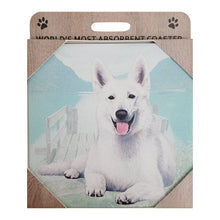10 Ways You Can Read Your German Shepherd’s Mind
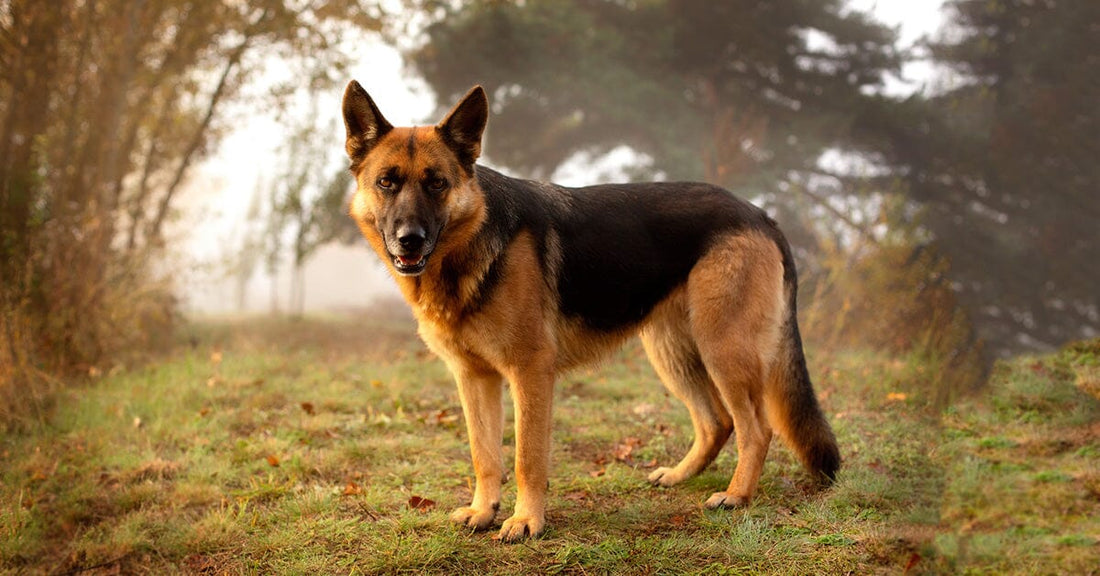
The bond that you share with your German shepherd is very close. At times, it seems your dog can read your mind. In truth, your dog is very intuitive and can pick up on your moods and emotions. But they are also masters at reading body language.
This is why staying calm during training or in an unexpected or anticipated situation is so important. By keeping your composure, your dog will read your verbal and body cues and respond accordingly. Conversely, if you get anxious and excited, it is more likely that your dog will, too.
However, your dog is not the only one skilled at non-verbal communication. Have you ever felt like you can read your dog’s mind? You’ve most likely experienced this ‘knowing’ just before your dog did something you just knew they were going to do.
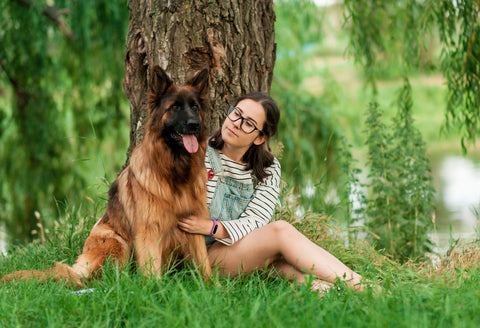
Sure, it’s easy to understand them when they bark, whine, growl, or cry. Your dog has many forms of this type of communication. For example, their excited bark is much different from their warning bark. Their whine to go outside is much different from a cry of pain or alarm.
Learning how to decipher your dog’s communication is almost like reading their mind. However, you can go much further so that even when they are not making a sound, you can still understand what they’re feeling.
You can do this by learning what their body language means. Reading their body language is very important, even more important than listening to their verbal cues. This language includes the position of the ears, tail, eyes, stance, and overall body posture.

Understanding your dog’s body language will seemingly enable you to read their mind. It will help you with training, rewarding, and reducing stress. It will also enable you to notice changes in your dog’s mood or health status, strengthen the bond you share, and help protect you and your pet because you can learn to react before they do.
Here are some tips on how to read your dog’s body language:
1. What Their Tail Says About Their Mood
Your dog’s tail says a lot about their mood. Of course, you know when they are happy because they wag it as they rush to greet you. But dogs will also wag their tail when they are aroused by anything. In other words, they may see or hear something and react with the movement of their tail.
High tail-when your dog holds their tail high it means they are excited, alert, aroused, or dominant. If your dog suddenly holds their tail up, it’s a good idea to look around to see what has captured their attention so intently to avoid an unwanted reaction to a situation.
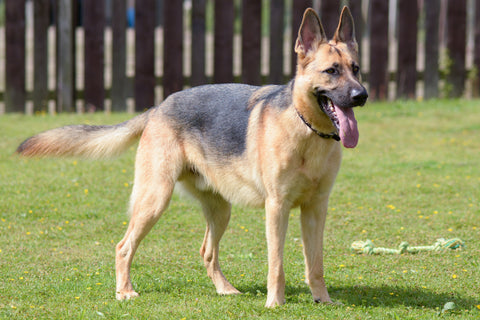
Flicking tail-if your dog has a high tail that is also flicking rapidly back and forth, also known as flagging, it may mean they are ready to defend their ground or are ready to fight. Conversely, if your dog is approached by a dog that is flagging, it’s a good idea to calmly get out of there, if possible.
Helicopter tail-You don’t see a full circle wag or helicopter tail often on Germans shepherds, if ever. Usually, their tail is wagging back like a pendulum. But both types of wags signal they are happy, such as when you’re getting ready to play or go for a walk and the dog’s hind end is also relaxed.
Low wagging tail-not all wagging tails signal happiness. If a dog is stiff in their hind end and has a low wag (fast or slow) it can mean the dog is insecure, uncertain, and even conflicted. Dogs wagging like this may bite.
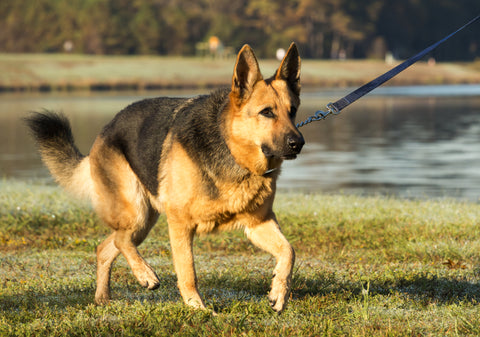
Tucked tail-A low, tucked, or placid tail can indicate your dog is feeling fearful or submissive. If it’s tucked between the legs, it also indicates fear but also means your dog feels threatened. The more anxious your dog is feeling, the closer they will hold it to their body. If your dog has a limp, hanging tail for no reason that doesn’t go away, it can also mean they have an injury to their spine or tail.
Left or right wag-A study from Current Biology found that dogs that wag from their right are feeling confident or want companionship. But when they wag from their left, it can mean they are anxious or want to withdraw from a situation. So next time your dog wags, take a look and see which way they are waging.
2. How Their Posture/Stance Shows Off Their Mood
Laying on their back-when dogs lay on their back it means they are calm, comfortable, and feel safe. They may be asking for a belly rub or even taking a nap. Either way, they are happy, not stressed, free from anxiety, and are trusting you.
Ridged stance-A ridged, straight stance means your dog is on high alert. They may be watching or listening to something.
Relaxed stance-when your dog is relaxed, their body is neutral with their weight balanced on all four paws and their tail is down or wagging. Their face looks relaxed, and their mouth may be open or closed.
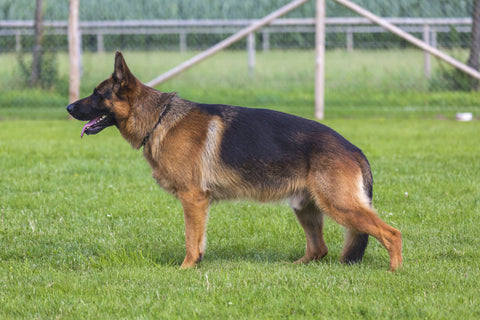
Submissive stance-when your dog feels submissive, they will be standing on four paws with their head lowered. They may crouch to try to look smaller and tuck their tail. They will usually avoid eye contact or quickly look away.
Raised hackles-If your dog raises the hair on the back of their neck and down the spine, it means they have raised their hackles. Raised hackles mean your dog is very aroused, curious, possibly feeling stress, or is being territorial. When your dog has raised hackles, the hair on their tail may also puff out. Notice your dog looks bigger with their hair raised.
Play bow-The play bow is an adorable signal that your dog wants to play. They will do this to initiate play with your or even other dogs. When they play bow, they will have their front legs stretched out in front of them, their chest near the ground, and their rear in the air.
3. Why They Mount/Hump
Mounting or humping is that embarrassing behavior that every dog owner wishes never happened. Mounting is not usually about mating, however. It usually means the dog is overstimulated, feeling dominant, stressed, or may even have a medical problem so if it happens often, you may want to talk to your vet.
4. Why They Yawn When They’re Not Tired
Dogs are known to yawn when they are tired or even when they see their human yawn. But if they yawn in certain situations, it can also be a sign of stress. You might see your dog yawn at the vet or in a new situation. If you do, they are indicating they are feeling a little nervous and need some reassurance.
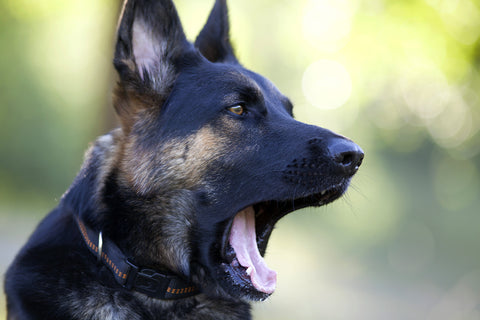
5. Showing Off Their Teeth
The snarl is the universal sign that the dog is telling you to back off because they are feeling aggressive and may bite.
6. Ear Positions Are More Than Just Listening
Ears pointed up-when your dog has their ears up and facing forward, it means they are in their neutral position.
Ears pulled back flat-If your dog pulls their ears back flat against their head, it can be a sign of fear or aggression, so you’ll have to read the situation to decide which one.
Holding the ears down and slightly back-It is normal for dogs to pull their ears back. They may be listening to something, excited, wanting their head rubbed, or even protecting their ears. If the rest of their body language is relaxed, it’s just a normal ear position. But if they are holding their ears back and seem stressed, it could mean they are scared, uncomfortable, or feeling submissive. If they hold one ear back or down, it could be a sign of discomfort, like an ear infection.
7. What Eye Contact Really Means
Eye gazing-when your German shepherd looks into your eyes, it’s like they are giving you a hug. Dogs don’t gaze for long usually and it’s normal for them to look away.

Avoiding eye contact-if your dog is avoiding eye contact, it means they are stressed or tense about something.
Whale eyes-if your dog is showing the whites of their eyes, it means they are uncomfortable, worried, or having anxiety about something. Dogs showing the whites of their eyes are distressed.
8. Identifying Anxiety and Stress
If your dog feels anxiety or stress, they’ll let you know. Their ears will be lowered, and their tail will be down. They may walk more slowly or even pace back and forth. Often, they will repeatedly yawn and pant.
9. Pain and Illness Signals
German shepherds are stoic dogs that will often hide their pain and sickness. So, if they are demonstrating a health problem, it is important to evaluate them. They may flatten their ears or one ear, tremble, pant, pace, retch, crouch, have trouble standing, or limp. They may show the whites of their eyes, have half-opened eyes, or even stare. They make lick, scratch, or bite the area bothering them. The best thing you can do is have any unusual changes in behavior evaluated by your vet.
10. What Aggression Looks Like
German shepherds are protective dogs but that doesn’t mean they should be reactive dogs. But if they do get aggressive in a situation, their posture will be tense, they will stare at the object of their attention, and they may show their teeth and raise their hackles. Their ears may be forward or back and their tail will be ridged and may flick.

We hope that these clues help you read your dog’s mind and deepen your relationship. As always, please feel free to share with your friends.
You may also like: Can Your German Shepherd Read Your Mind?


















